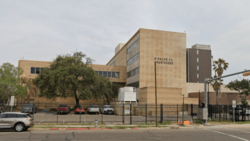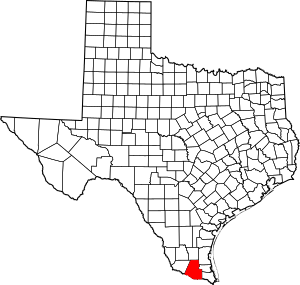Hidalgo County, Texas facts for kids
Quick facts for kids
Hidalgo County
|
|||
|---|---|---|---|

The Hidalgo County Courthouse at Edinburg in 2024
|
|||
|
|||

Location within the U.S. state of Texas
|
|||
 Texas's location within the U.S. |
|||
| Country | |||
| State | |||
| Founded | January 24, 1852 | ||
| Named for | Miguel Hidalgo y Costilla | ||
| Seat | Edinburg | ||
| Largest city | McAllen | ||
| Area | |||
| • Total | 1,583 sq mi (4,100 km2) | ||
| • Land | 1,571 sq mi (4,070 km2) | ||
| • Water | 12 sq mi (30 km2) 0.81% | ||
| Population
(2020)
|
|||
| • Total | 870,781 | ||
| • Estimate
(2022)
|
888,367 |
||
| • Density | 550.08/sq mi (212.39/km2) | ||
| Time zone | UTC−6 (Central) | ||
| • Summer (DST) | UTC−5 (CDT) | ||
| Congressional districts | 15th, 34th | ||
Hidalgo County is a large county in the U.S. state of Texas. In 2020, about 870,781 people lived here. This makes it the ninth-biggest county in Texas by population. It is also the largest county not located in the "Texas Triangle" area.
The main city where the county government is located is Edinburg. The biggest city in the county is McAllen. Hidalgo County is named after Miguel Hidalgo y Costilla. He was a priest who helped start Mexico's fight for independence from Spain.
This county is in the Rio Grande Valley part of South Texas. It is one of the fastest-growing counties in the United States. The U.S. Census Bureau calls it the McAllen–Edinburg–Mission metropolitan statistical area. This area also connects with Starr County.
Most people in Hidalgo County are of Hispanic background. In 2020, about 91.9% of the population was Hispanic. This makes it the second-largest county in Texas with a majority Hispanic population. It is also the largest county in the U.S. where over 90% of people are Hispanic.
Contents
About Hidalgo County
Hidalgo County is the southernmost county in the United States that is not next to the ocean. It is a place with a lot of natural beauty and resources.
Where is Hidalgo County?
The United States Census Bureau says the county covers about 1,583 square miles. Only about 12 square miles of this area is water.
The northern part of the county has sandy and light soils. These soils are good for farming. In the southern part, the soils are deeper and also good for growing crops. Along the Rio Grande river, you can find brown and red clay soils.
Hidalgo County is part of the South Texas Plains. This area has many grasses, mesquite trees, and other plants. Some native plants include chapote, guayacán, ebony, and yucca. Many of these native plants have been reduced because of farming.
The county has natural resources like caliche, sand, gravel, oil, and natural gas. The climate here is warm and humid. Temperatures usually range from about 47°F (8°C) in January to 96°F (36°C) in July. The average temperature for the year is about 73°F (23°C). The county gets about 23 inches (584 mm) of rain each year. The growing season for plants lasts for about 320 days.
Major Roads
Many important roads run through Hidalgo County. These roads help people travel and transport goods.
 Interstate 2
Interstate 2 Interstate 69C (Under Construction)
Interstate 69C (Under Construction) U.S. Highway 83
U.S. Highway 83 U.S. Highway 281
U.S. Highway 281 Texas State Highway 107
Texas State Highway 107 Texas State Highway 186
Texas State Highway 186 Texas State Highway 336
Texas State Highway 336 Texas State Highway 495
Texas State Highway 495 Farm to Market Road 364
Farm to Market Road 364 Farm to Market Road 490
Farm to Market Road 490 Farm to Market Road 492
Farm to Market Road 492- 20px Farm to Market Road 493
 Farm to Market Road 494
Farm to Market Road 494 Farm to Market Road 676
Farm to Market Road 676 Farm to Market Road 681
Farm to Market Road 681 Farm to Market Road 907
Farm to Market Road 907 Farm to Market Road 1016
Farm to Market Road 1016 Farm to Market Road 1017
Farm to Market Road 1017 Farm to Market Road 1423
Farm to Market Road 1423 Farm to Market Road 1426
Farm to Market Road 1426 Farm to Market Road 1924
Farm to Market Road 1924 Farm to Market Road 1925
Farm to Market Road 1925 Farm to Market Road 2061
Farm to Market Road 2061 Farm to Market Road 2557
Farm to Market Road 2557 Farm to Market Road 3072
Farm to Market Road 3072
Neighboring Areas
Hidalgo County shares borders with several other counties and cities. It also borders municipalities in Mexico.
- Brooks County (north)
- Kenedy County (northeast)
- Willacy County (east)
- Cameron County (east)
- Starr County (west)
- Gustavo Díaz Ordaz Municipality, Tamaulipas, Mexico (south)
- Reynosa Municipality, Tamaulipas, Mexico (south)
- Río Bravo Municipality, Tamaulipas, Mexico (south)
- Matamoros Municipality, Tamaulipas, Mexico (south)
- Camargo Municipality, Tamaulipas, Mexico (south)
Protected Natural Areas
Part of the Lower Rio Grande Valley National Wildlife Refuge is in Hidalgo County. The Santa Ana National Wildlife Refuge is also located here. These areas help protect local wildlife and plants.
People and Population
The population of Hidalgo County has grown a lot over the years.
| Historical population | |||
|---|---|---|---|
| Census | Pop. | %± | |
| 1860 | 1,182 | — | |
| 1870 | 2,387 | 101.9% | |
| 1880 | 4,347 | 82.1% | |
| 1890 | 6,534 | 50.3% | |
| 1900 | 6,837 | 4.6% | |
| 1910 | 13,728 | 100.8% | |
| 1920 | 38,110 | 177.6% | |
| 1930 | 77,004 | 102.1% | |
| 1940 | 106,059 | 37.7% | |
| 1950 | 160,446 | 51.3% | |
| 1960 | 180,904 | 12.8% | |
| 1970 | 181,535 | 0.3% | |
| 1980 | 283,229 | 56.0% | |
| 1990 | 383,545 | 35.4% | |
| 2000 | 569,463 | 48.5% | |
| 2010 | 774,769 | 36.1% | |
| 2020 | 870,781 | 12.4% | |
| 2022 (est.) | 888,367 | 14.7% | |
| U.S. Decennial Census 1850–2010 2010-2020 |
|||
In 2010, there were 774,769 people in the county. About 90.6% of these people were of Hispanic or Latino background. The average age of people in the county was 28.3 years old. About 34.7% of the population was under 18 years old.
Schools and Learning
Hidalgo County has many school districts that serve its students.
- Donna Independent School District
- Edcouch-Elsa Independent School District
- Edinburg Consolidated Independent School District
- Hidalgo Independent School District
- La Joya Independent School District
- La Villa Independent School District
- Lyford Consolidated Independent School District (partial)
- McAllen Independent School District
- Mercedes Independent School District
- Mission Consolidated Independent School District
- Monte Alto Independent School District
- Pharr-San Juan-Alamo Independent School District
- Progreso Independent School District
- Sharyland Independent School District
- Valley View Independent School District
- Weslaco Independent School District
The county is also served by the South Texas Independent School District. This district covers several counties. The Roman Catholic Diocese of Brownsville also runs several schools in the area.
For higher education, the Edinburg campus of the University of Texas Rio Grande Valley is located in Hidalgo County. This university used to be called the University of Texas-Pan American. All of Hidalgo County is also served by South Texas College. This college has several campuses in the county, including Pecan, Mid-Valley, Technology, and Nursing & Allied Health campuses.
What the County Produces
In 2020, the total value of products made in Hidalgo County was $11.5 billion.
In 1982, most of the land in the county was used for farms and ranches. About 52% of the farmland was cultivated, and 85% of that was irrigated. Hidalgo County was a leader in Texas for growing vegetables like cabbage, onions, cantaloupes, carrots, and watermelons. It also grew fruits like grapefruit, oranges, and pecans. Farmers also raised cattle, milk cows, and hogs. Hidalgo is the top county in Texas for producing oilseeds and dry beans.
A type of tick called the Southern Cattle Tick can be found here. These ticks can cause problems for animals. Efforts are made to control their spread.
Media in Hidalgo County
The county has many ways for people to get news and entertainment.
Newspapers
- The Community Press
- The Valley Town Crier
- The Monitor
- The Mercedes Enterprise
- RGV Business Journal
- The Progress Times
- Texas Border Business
- Mega Doctor News
Radio Stations
- KGBT 98.5 FM
- KGBT 1530 AM
- KBTQ 96.1 FM
- KFRQ 94.5 FM
- KKPS 99.5 FM
- KNVO 101.1 FM
- KVLY 107.9 FM
- KURV 710 AM
- KVMV 96.9 FM
- KTEX 100.3 FM
- KQXX 105.5 FM
Magazine
- Contempo Magazine
Cities and Towns
Hidalgo County is home to many cities and smaller communities.
Cities
Census-designated places
These are areas that are like towns but are not officially incorporated as cities.
- Abram
- César Chávez
- Citrus City
- Cuevitas
- Doffing
- Doolittle
- Harding Gill Tract
- Hargill
- Havana
- Heidelberg
- Indian Hills
- La Blanca
- La Coma Heights
- La Homa
- Laguna Seca
- Linn
- Llano Grande
- Lopezville
- Los Ebanos
- Midway North
- Midway South
- Mila Doce
- Monte Alto
- Muniz
- Murillo
- North Alamo
- Olivarez
- Palmview South
- Perezville
- Relampago
- Salida del Sol Estates
- San Carlos
- Scissors
- South Alamo
- Villa Verde
- West Sharyland
Unincorporated community
See also
 In Spanish: Condado de Hidalgo (Texas) para niños
In Spanish: Condado de Hidalgo (Texas) para niños



